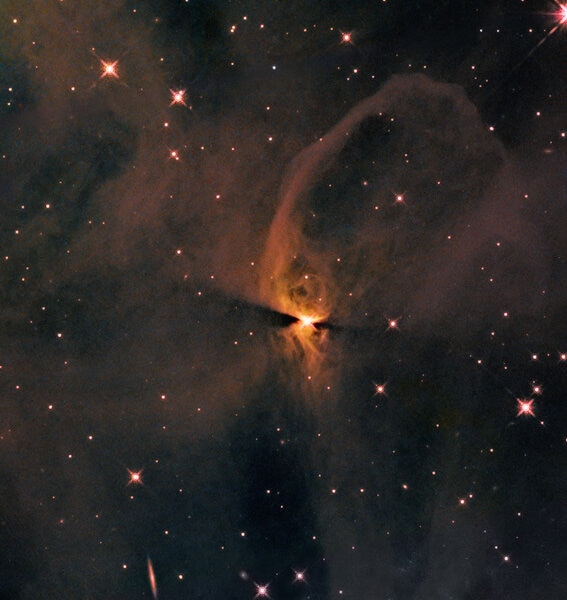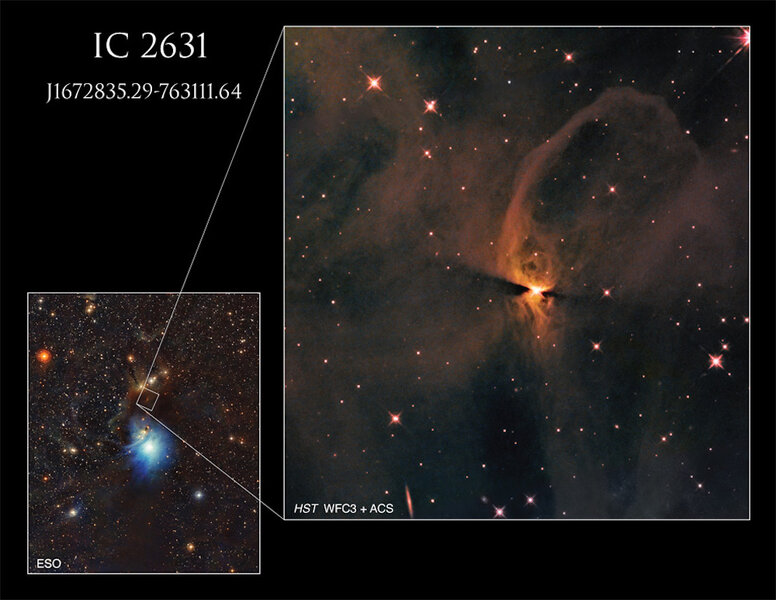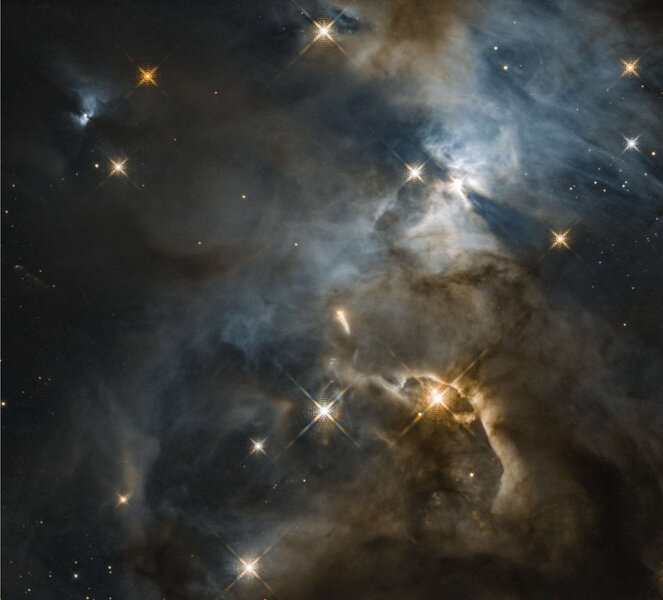Being thankful: Hubble sees a baby star's shadow play
A protostar's disk casts a long shadow across the sky.

Today is Thanksgiving, a holiday where Americans traditionally take a moment to reflect on the good things in life, and be thankful for them. It takes many forms for different people — family, friends, health, food, and sometimes just a general appreciation for life.
In those terms, let me say I'm thankful for Hubble Space Telescope.
There are lots of reasons, including having the pleasure and honor of being affiliated with it, getting a degree and a job working with it for some years.
But most importantly, it's because it changed the way we see the Universe. Due to its keen and unfettered vision — and the scientists who pointed it and the visual artists who create its stunning cosmic portraits — it brought astronomy into the public consciousness better than nearly any other machine before it. They finally got to see the majesty over our heads the way astronomers had imagined it for decades.
But it also literally changed the way we see the Universe.
As an example, let me present to you the prosaically named J1672835.29-763111.64, a young star just getting its start in the galaxy.
J1672 (let's call it*) is a star still in the process of formation, still surrounded by the material from which it's being born. It has a mass of about 1/3 that of the Sun, and is only about 1% as luminous, so it's wee, and will probably wind up being what we call an M-type red dwarf: cool, faint, and low-mass. It's part of a complex of star-forming clouds called IC 2631 in the constellation Chamaeleon about 500 light years from Earth.
This infrared image was taken as part of a larger program to take quick “snapshot” images of very young stars. The survey will revisit them over time to look for changes in the nebulosity around them and in the brightness of the stars; in fact Spitzer Space Telescope observations of J1672 show it varies in brightness by up to a factor of 2 over a period of about 8 days. That period is consistent with how fast young stars spin, implying it could be due to starspots — young low-mass stars have very powerful magnetic fields, and sun/starspots are inherently magnetic phenomena. But the large variation in brightness implies huge spots, far larger than is realistically possible.
Instead, the variability may be due to outside influences. J1672 has a disk of material around it, extremely common in still-forming stars. Infalling material from the cloud of gas and dust around them naturally falls into a disk that can not only feed the star but also form planets around it; we call these protoplanetary disks or proplyds. These disks are sometimes warped, like the brim of a fedora or a cowboy hat (or, seriously, like the disk of our galaxy). This could periodically partially block some of the star's light, changing the brightness we see. The dust in the disk reddens the light, too, which is also seen in here; the star gets redder when it gets fainter.
That's cool, and nice indirect evidence of a disk. But there's more evidence for a disk, evidence you can see. Take another look at the image. See that dark shadow going across the glowing material around the star?
That's literally a shadow. It's the disk illuminated by J1672 casting a shadow on the material around it! The disk is far too small to be seen on this scale, but the shadow it throws is huge, over a trillion kilometers long.
If the disk is causing the changes in the star's brightness the shadow may be changing as well over time. Further (planned!) observations may reveal that.
This has been seen before, too! The star HBC 672 (also called EC 82) is similar to J1672, casting a bat-like shadow on material around it, and Hubble observations taken over time show the shadow “flapping”!
That's amazing. When I think of stars, I tend to think of them as unchanging over human timescales, or at least changing in ways that are obscure and difficult to measure. But here you can simply see it!
Also, it was Hubble observations of the magnificent Orion Nebula that first clued us in to proplyds, revealing dozens of them cocooning young stars in the nebula ready to fledge. Later telescopes that can see in infrared, like Spitzer and others, were then used to learn much more about them.
This is no esoteric idea, either. I ask you to look once again at that image. 4.6 billion years ago, that was you. Not metaphorically, not figuratively or poetically, but in a very real and literal sense. Our Sun formed out of such a nebula, material collapsing and gathering itself, a disk forming in the center, the Sun forming in the center of that, the disk filled with bits of microscopic grains of dust and molecules of gas, those bits colliding and sticking together, growing ever larger, until they formed pebbles and then rocks and then boulders and then planetesimals a kilometer wide and then protoplanets…
And then Earth. And, eventually, you. And me, and everyone you know or ever heard of or haven't heard of and everything you see around you. All of it.
And all revealed by Hubble in fantastic images like this.
There are bigger ‘scopes, and ones that see at wavelengths Hubble can't, and are designed to investigate some objects far better than Hubble can.
But it was Hubble that brought it home to us, in this case metaphorically and literally.
And for that I'm very, very thankful.
Happy Thanksgiving.
*Stars are sometimes designated by their coordinates on the sky (similar to latitude and longitude on Earth), which is handy for astronomers trying to figure out which is which in an image. However, different units can be used to label coordinates, causing confusion. The name J1672835.29-763111.64 refers to the longitudinal coordinates in degrees (167° 28 minutes 35.29 seconds) but astronomers also use “hours” for that first number, referring to the fact it takes the Earth 24 hours to spin once, so one hour = 15°. In that system this star is called J11095437-7631113 (11 hours 9 minutes 54.37 seconds). I mention this because it took me a while to track down this star in other papers because different names were used.





























